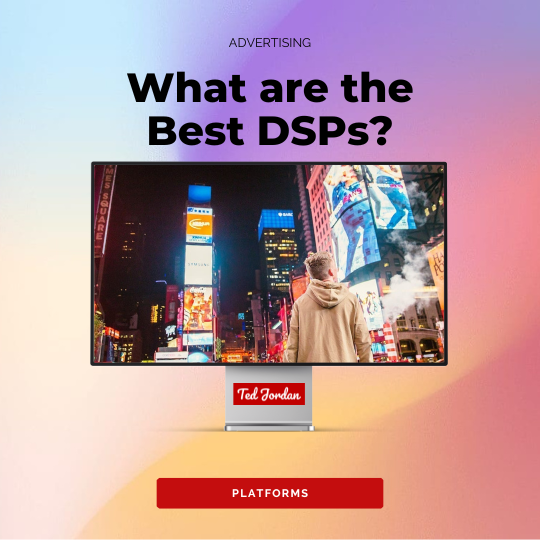Before advertising through Programmatic, define your ideal customer and learn how to reach the right audience. Each Programmatic ad format has its own specificities in terms of ad placements, targeting options, tracking and optimisation features.
Today, learn how to reach the right audience for your marketing campaigns. Discover 11 audience targeting options offered in Programmatic Advertising.

Define your audience
Before targeting your ideal customers, you must define your audience, who you want to reach. To do so, check who your competitors are targeting, do a market survey, analyse the collected data about your current customers, collect information from your CRM or website…
Ask yourself:
- Who is buying my product or service?
- How old are my customers?
- Are my customers mainly male or female?
- Do they have children?
- Do they live in the countryside or in big cities?
- What do they do for a living? Are they students?
- Is the marital status of my customers important?
- What language(s) do they speak?
- What are their hobbies and habits?
Once you defined your audience, your persona, you can check how to reach it through Programmatic. Be ready because there are many audience targeting options available!

Programmatic targeting options
Audience targeting in Programmatic allows you to reach your ideal customers while saving money. Indeed, you’re only delivering ads to the people you want to reach: so you’re only paying for qualitative traffic.
Data is gold in audience targeting.
Data-based targeting originates from different parties:
- Zero-party data is intentionally shared by users with a brand.
- First-party data is collected by a brand after a user action.
- Second-party data is shared through a partnership between two brands; it’s someone else’s 1st-party data.
- Third-party data is collected from different sources.
With a cookieless word ahead, know that there are several cookieless targeting options available in Programmatic.
But make sure your targeting strategy is compliant with local authorities: GDPR for Europe, CCPA for California, etc.
Note that the Programmatic audience targeting options we will mention can also be used for exclusion purpose. For example, exclusion lists can save you time when setting a campaign: if you want to target all US states but 5 for your campaign, target the United States and add an exclusion list with the 5 states you want to exclude.
It’s much quicker than adding, one by one, all the 45 states you want your ads to deliver in.
Behavioural
Behavioural targeting, sometimes called “audience targeting”, tracks users’ hobbies, interests and habits. You can target an audience based on the web pages they visit, which product they buy (online or in-store), or what links they click.
For example, if you sell yoga mats, you could target all the users who ordered related products through Amazon: yoga pants, yoga cushions, yoga outfit, etc. This is possible through mail and receipts targeting.
Demographic
Demographic, or “audience data”, is one of the most basic Programmatic targeting options. You can choose from a large array of targeting options: age, gender, language, country, income, parental and marital status, education, time of the day or day of the week, etc.
Know that it’s also possible to target “unknown” audiences on some Demand-Side Platforms: it allows you to reach more users. But if your product or service is for adults only, for example, you will not be able to target “unknown” audiences for legal reasons.
For example, if you offer B2B services, you could target all users who are business owners, who have a certain income and who are interested in Business and Marketing. Then, you could set your ads to only deliver during and around business hours.
When targeting specific hours, be aware of any time-zone difference within and between the American states.
Geotargeting
Geotargeting is really useful for drive-to-store campaigns or DOOH. Depending on which country you advertise in, you can use geofencing, radius targeting, store beacons, device IDs, DMAs (Designated Market Areas), postcodes, cities, states, countries, to reach the right audience for your brand.
For example, if you want to bring more customers to your clothing shop, you could target all the devices around a certain distance from your store: laptops, mobile phones, tablets, CTVs, DOOH screens. If you know that people from a certain area are not your ideal customers, you could exclude them using DMAs.

Custom audiences
Programmatic platforms offer targeting options with a high-level of customisation. Know that’s it’s possible to target or exclude users from a custom audience list that you create. In this list, you would use some or all the targeting options we mention. Isn’t it handy?
In these custom audiences, you can use first-, second- or/and third-party data.
Usually custom audiences are created with OR/AND rules. This allows you to target users who are in audience A or in audience B, or who are in audience A and in audience B.
For example, if you sell earplugs for concerts, you could target music lovers who bought a concert ticket during the last 90 days OR users who searched for “earplugs” during the same period of time.
Keyword targeting
Keyword targeting, or search targeting, is used in contextual targeting. This method matches users who searched for specific keywords with related ads.
For example, if you are selling golf clothes, you could target all the users who searched for “golf club”, “golf membership”, “golf equipment”, etc. Then your ads would appear on websites visited by the users who entered these keywords.
Retargeting
Retargeting allows advertisers to re-engage users. These users may have visited a website, left a product in their shopping cart without buying it, or bought a product a long time ago but never came back to the website since.
Retargeting is used to display ads to these users, to convince them to take action.
For example, for lead gen campaigns, you could retarget all the users who started filling a form but never finished it. Seeing your ads would remind them about your product or service and they would be more inclined to convert.
Lookalike audiences
Lookalike targeting helps you reach audiences that look like a source audience; this source audience could be your current customers.
Lookalike audiences are great to increase your reach and discover new converting audiences.
For example, if your clients are living in huge cities, you could use Lookalike targeting to show your ads to other persons living in big cities.
Predictive audiences
Predictive audiences are similar to Lookalike audiences with the exception that more accurate data is taken into account. Usually this data comes from zero or first-party sources.
Predictive targeting uses machine learning and data to build audiences that are most likely to do at least one defined action within a period of time.
For example, if the majority of your customers subscribe to your newsletter 10 days after visiting your website, you could create Predictive audiences and reach more potential converters with this type of Programmatic targeting. The reach with Predictive targeting is often less important than with Lookalike targeting but the conversion rate if often higher.
Contextual targeting
Contextual targeting allows brands to advertise personalised ads to users based on categorised web content: semantic, categories and keywords.
For example, if you own a hotel, you could target holiday goers with contextual targeting and appear on websites that offer related content: flight tickets booking platforms, blogs about travel, YouTube vlog channels, etc.
This type of targeting is often compared to behavioural targeting. Learn more about Contextual vs Behavioural targeting in this article.
Device targeting
Device targeting allows brands to target their preferred audience based on the type of devices they use: laptop, tablet, CTV, mobile phone, iOS vs Android… It’s also possible to target users owning a device with a specific software version.
For example, if you created an app for iOS users, you could target all the people who own a Mac or an iOS phone, and exclude all the Android users.

IP targeting
IP targeting, as the name suggest, allows advertisers to target an audience using IP addresses. IP addresses can be collected through app installations, website registrations, web browsers, etc.
It’s important to note that IP targeting can be subject to regulations such as GDPR if you advertise in Europe.
For example, if you own a restaurant, you could target IP addresses linked to hotels near you, to attract customers. Most of the time, people connect their devices straight away to the Wi-Fi after checking-in.
Explore more Programmatic targeting options
There are more audience targeting methods in Programmatic, some that may be better for omnichannel campaigns or cross-device targeting, like cookieless solutions.
Learn more about cookies and these targeting options: join our Programmatic online training and receive the help of Ted Jordan, our Programmatic expert, for your next campaign.





One Response
Great read! I found some useful takeaways that I’ll definitely apply. Thanks for sharing.